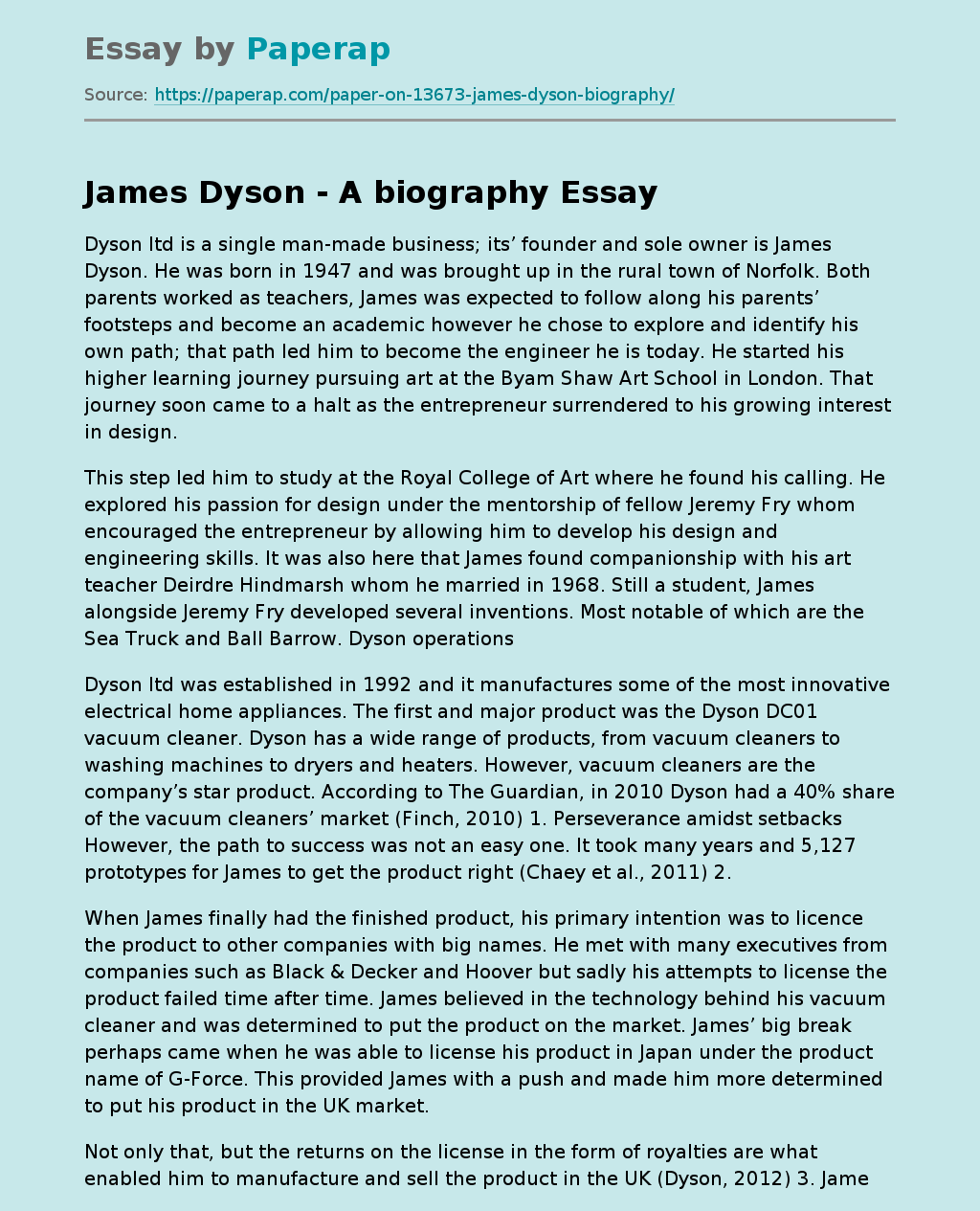James Dyson - A biography
Dyson ltd is a single man-made business; its’ founder and sole owner is James Dyson. He was born in 1947 and was brought up in the rural town of Norfolk. Both parents worked as teachers, James was expected to follow along his parents’ footsteps and become an academic however he chose to explore and identify his own path; that path led him to become the engineer he is today. He started his higher learning journey pursuing art at the Byam Shaw Art School in London.
That journey soon came to a halt as the entrepreneur surrendered to his growing interest in design.
This step led him to study at the Royal College of Art where he found his calling. He explored his passion for design under the mentorship of fellow Jeremy Fry whom encouraged the entrepreneur by allowing him to develop his design and engineering skills. It was also here that James found companionship with his art teacher Deirdre Hindmarsh whom he married in 1968.
Still a student, James alongside Jeremy Fry developed several inventions. Most notable of which are the Sea Truck and Ball Barrow. Dyson operations
Dyson ltd was established in 1992 and it manufactures some of the most innovative electrical home appliances. The first and major product was the Dyson DC01 vacuum cleaner. Dyson has a wide range of products, from vacuum cleaners to washing machines to dryers and heaters. However, vacuum cleaners are the company’s star product. According to The Guardian, in 2010 Dyson had a 40% share of the vacuum cleaners’ market (Finch, 2010) 1.
Perseverance amidst setbacks However, the path to success was not an easy one. It took many years and 5,127 prototypes for James to get the product right (Chaey et al., 2011) 2.
When James finally had the finished product, his primary intention was to licence the product to other companies with big names. He met with many executives from companies such as Black & Decker and Hoover but sadly his attempts to license the product failed time after time. James believed in the technology behind his vacuum cleaner and was determined to put the product on the market. James’ big break perhaps came when he was able to license his product in Japan under the product name of G-Force. This provided James with a push and made him more determined to put his product in the UK market.
Not only that, but the returns on the license in the form of royalties are what enabled him to manufacture and sell the product in the UK (Dyson, 2012) 3. James’ vision of a “vacuum revolution” was in sight (Dyson, 2011) 4. Years of testing, product development and failed licensing attempts would have been enough to deter the average person from carrying on with their vision and their dream. Evidently, that was not the case with James Dyson as all these factors proved to become fruitful. Hoover was one of the companies that turned James down thinking that a bagless vacuum cleaner would not sell.
Quite cynically, it was also Hoover that was sued by Dyson for infringement of its patent rights in 1999 after Hoover brought out the Triple Vortex model (Carruthers, 2007) 5. Childhood events foster entrepreneurialism Being an engineer, James has a keen eye for design and a mind that likes to challenge the way things work. He is always interested in producing something that is better and more efficient. That combined with the aggravation of having to settle for conventional goods are the internal driving forces that led him to set up Dyson ltd.
However, his success cannot only be attributed to the factors mentioned. It was the financial and emotional support of his wife Deirdre that allowed him to persevere and dedicate himself to building what now is a hugely successful business. James lost his father at the age of 9; in an interview with Beard, he reveals that having suffered that loss made him feel very different and unusual, subsequently that created the need for him to prove himself (Beard, 2012). His determination is also drawn from his favourite sport; long distance running. Growing up, he was always keen on taking a challenge.
James believes that what a person may lack in talent he may make up for in determination. In his autobiography, he shares that he was good at this sport not because he was physically fit but because he was more determined than others (Dyson, 2012) 7. James Dyson was able to create success because he has the building blocks of an entrepreneur as well as a solid support system around him. James was able to achieve personal success by setting up Dyson ltd, he was also able to achieve financial success as the Sunday Times placed him on their rich list with a fortune worth 1. 45bn (Sunday times, 2011) .
His traits of determination, innovation, perseverance and risk taking allowed him to make a success of himself. Nonetheless, it is without a doubt that James would not have been able to reach his position if it weren’t for extrinsic factors. Working under the mentorship of Jeremy Fry allowed him to explore engineering and design. The unwavering support of his wife Deirdre also allowed him to focus on his goals and believe in his ideas.
James Dyson - A biography. (2018, Jan 30). Retrieved from https://paperap.com/paper-on-13673-james-dyson-biography/

